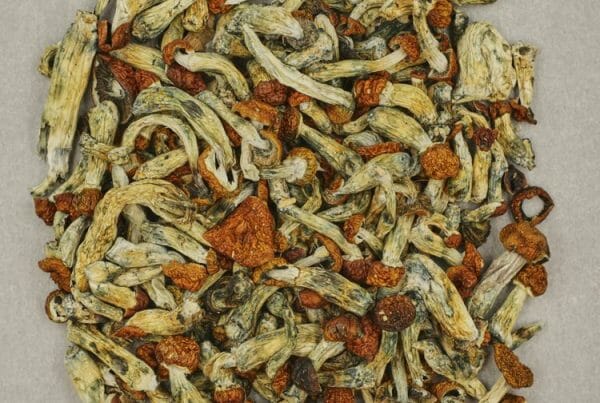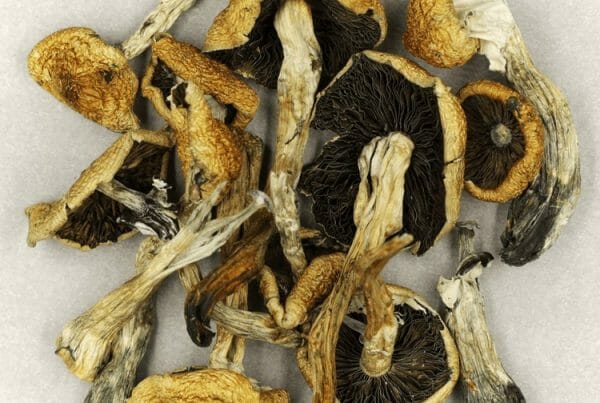Magic mushrooms online Canada are capturing the attention of those intrigued by the intersection of evolution and psychedelics through the lens of the Stoned Ape Theory. This theory suggests that our human ancestors experienced cognitive evolution due to psilocybin mushrooms.
Terence McKenna, an American ethnobotanist and mystic, offered this unconventional theory.
Is this difficult to believe, or could McKenna have been onto something?
Table of Contents
Key Takeaways:
- Stoned Ape Theory states that psilocybin mushrooms may have played a role in human consciousness and cognitive abilities.
- Psilocybin raises the level of awareness of states of consciousness.
- Research says compounds in magic mushrooms provide therapeutic effects for mental health issues like panic attacks and PTSD.
What is the Stoned Ape Theory
It is a provocative hypothesis proposed by Terence McKenna, an influential ethnobotanist and advocate for psychedelics. The theory suggests that the consumption of dried mushrooms played a role in the cognitive evolution of early humans.
According to McKenna, during the transition from Homo erectus to Homo sapiens, our ancestors stumbled upon Psilocybe cubensis, a mushroom that grew abundantly in cow dung. This unexpected addition to their diet may have catalyzed neurological changes. Their consumption changed their cognitive functions and fostered the development of language, art, and culture.
What Does the Stoned Age Theory Suggest
McKenna theorized that climatic shifts in Africa forced early humans to adapt their diets. As they followed herds of large herbivores, they encountered shrooms growing in animal excrement. They consume these fungi as a source of nutrients.
He argued that it could improve visual acuity and problem-solving skills, which correlated to early humans’ evolutionary advantage in hunting and social interactions. He claimed that “minor doses of psilocybin improve visual acuity,” which would have been beneficial for survival.
Cultural Development:
The theory posits that the psychedelic experience facilitated shifts in awareness, so it contributed to the emergence of language, religion, and artistic expression. McKenna famously stated that early humans “ate our way to higher consciousness.” These experiences shaped societal structures and cultural practices.
McKenna also noted the relationship between humans and cattle, as increased exposure to cow dung would have led to greater encounters with psilocybin shrooms. He believed this relationship fostered a “natural magic” that inspired early religious rituals and calendar-making.
The Role of Psilocybin in Human Consciousness
Psilocybin interacts with the brain by increasing connectivity between different regions. This connection results in a state of heightened awareness and altered perception.
According to Fatima Calvo from the Pontifical Catholic University of Peru, it “increases connectivity between networks in the frontal region and raises the level of awareness of states of consciousness.” This heightened connectivity can change cognitive functions so you can process your environment more effectively and creatively.
It also disrupts functional connectivity patterns in the brain. For example, researchers at Washington University found that it caused desynchronization within the default mode network (DMN), a network associated with self-referential thinking and daydreaming.
This desynchronization creates a temporary state where you experience a loss of ego and a heightened sense of connection to your surroundings. Joshua S. Siegel, a lead researcher in this area, noted that “the longer-term consequence is that it makes the brain more flexible and potentially more able to come into a healthier state.“
Criticism and Open Questions
One major criticism is the absence of fossil evidence supporting the theory. No archaeological findings directly link psilocybin consumption to cognitive advancements in early humans. Critics argue that the theory relies on speculation rather than empirical data.
Many believe it oversimplifies the complex factors contributing to human evolution, such as environmental changes and social interactions. If these substances were truly pivotal, similar cognitive advancements would likely be present in other species that use psychoactive substances.
Amanda Feilding, founder and director of the Beckley Foundation, argues that we should recognize McKenna’s key insight: humanity’s history intertwines with our fascination with psychedelic substances. She believes altered states of consciousness, even if experienced by early humans, likely positively impacted societal development.
“The imagery associated with the psychedelic experience is a recurring theme in ancient art,” Feilding explains. “I’m sure our early ancestors used psychedelics, along with other practices like dancing and music, to enhance their consciousness. This likely played a role in shaping their spirituality, art, and medicine.”
Stoned Ape Theory— A Door to Scientific Understanding
At best, the hypothesis is, as Paul Stamets, D.Sc., a psilocybin mycologist, said, an “unprovable hypothesis” that aligns with some, but not all, of our current understanding of human awareness evolution. McKenna deserves credit for proposing an idea in the 1990s that scientists have only recently confirmed: shrooms alter consciousness and can induce physical changes in the brain.
Drug researchers have found that shrooms induce a state of “unconstrained cognition” by triggering a surge in activity within the primitive brain network. Brain regions linked to emotion and memory synchronize similarly to sleep and dreaming patterns. At the same time, the brain’s higher-level cognitive functions, linked to the sense of self, become disorganized. This disruption is why some report a loss of “ego.”
The Psychedelic Renaissance and Magic Mushrooms in Canada
The Stoned Ape hypothesis may now occupy the world of fringe science. Scientists are now exploring its potential to treat conditions like substance abuse (legal and illegal drugs), anxiety, and depression. These scientists’ findings are slowly becoming a mainstream tool for positive change. In that sense, McKenna’s vision may be coming to fruition.
The Psychedelic Renaissance marks a resurgence of interest in psychedelics within both scientific and cultural contexts. This renewed focus stems from a growing recognition of the therapeutic ability of substances and their historical significance in human culture.
Scientific research has revitalized interest in these substances by demonstrating their ability to treat mental health disorders. Numerous studies have also investigated its safety. These studies suggest it has a better safety profile than opioids, which can cause multi-system organ failure. Psilocybin’s temporary physical effects include increased blood pressure and heart rate, headache, and nausea.
Canada’s Progressive Stance on Psychedelics
Canada has emerged as a leader in the psychedelic movement, particularly regarding research and therapy. The country has initiated several clinical trials exploring its efficacy for treating conditions such as depression and PTSD.
Health Canada has also granted exemptions for certain patients through a Special Access Program for psilocybin use as part of their treatment plans. Despite its complex status, like cannabis legalization, the presence of numerous dispensaries selling magic mushrooms Canada indicates a growing acceptance.
Purchasing Safe, Reliable Products Online
The interest in shrooms brings fort reliable online stores. People can find a trustworthy dispensary and product by looking at the following:
- Investigate Reputable Dispensaries: Seek out internet retailers with a solid reputation and open-sourcing policies. An illegal magic mushroom dispensary may sell fake products, but you can avoid them by reading the store’s policies.
- Verify Product Testing: To prevent contamination, make sure products undergo lab testing for potency and purity.
- Reading Reviews: Examine customer reviews to gauge the product’s calibre and the service’s dependability.
- Recognize Dosage Information: Learn the suggested dosages for various reactions (e.g., microdosing vs. macrodosing).
- Choose Secure Payment Methods: Use secure payment methods to safeguard your financial data while making purchases.
Zoomies Canada Connects Us to Our Primal Roots
Human evolution is a complex process involving numerous factors. While the exact role of shrooms in our development may remain unknown, they are undoubtedly contributing to the wellness of modern humans.
Zoomies Canada is a premier online store specializing in a diverse range of psilocybin products, including hallucinogenic mushrooms, shroom gummies, and microdosing capsules. We emphasize safety and quality by sourcing products from trusted growers that go thorough testing for potency and purity.
Frequently Asked Questions
What happens when shrooms change our consciousness?
Psychedelic alteration can include improvements in processing speed, memory, creativity, and problem-solving. It can also shift perspectives for lasting changes in worldview.
What is the biggest contribution of shrooms to society?
While many scientists and evolutionary experts may disagree about magic mushrooms’ contribution to human consciousness, their active compound is now central to multiple mental health treatments. Although this field is still relatively young, numerous studies have already demonstrated the substance’s positive impact, even showing greater efficacy than some traditional treatments.
What are the limitations of the Stoned Ape Hypothesis?
Human evolution is a multifaceted process driven by numerous factors, including genetics, environment, diet, social interactions, and more. McKenna’s proposal risks oversimplifying this complexity by attributing an evolutionary leap to a single factor: mushroom consumption.





